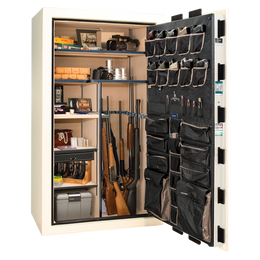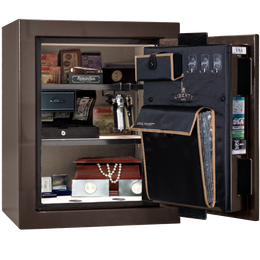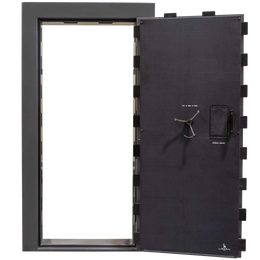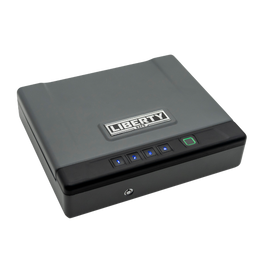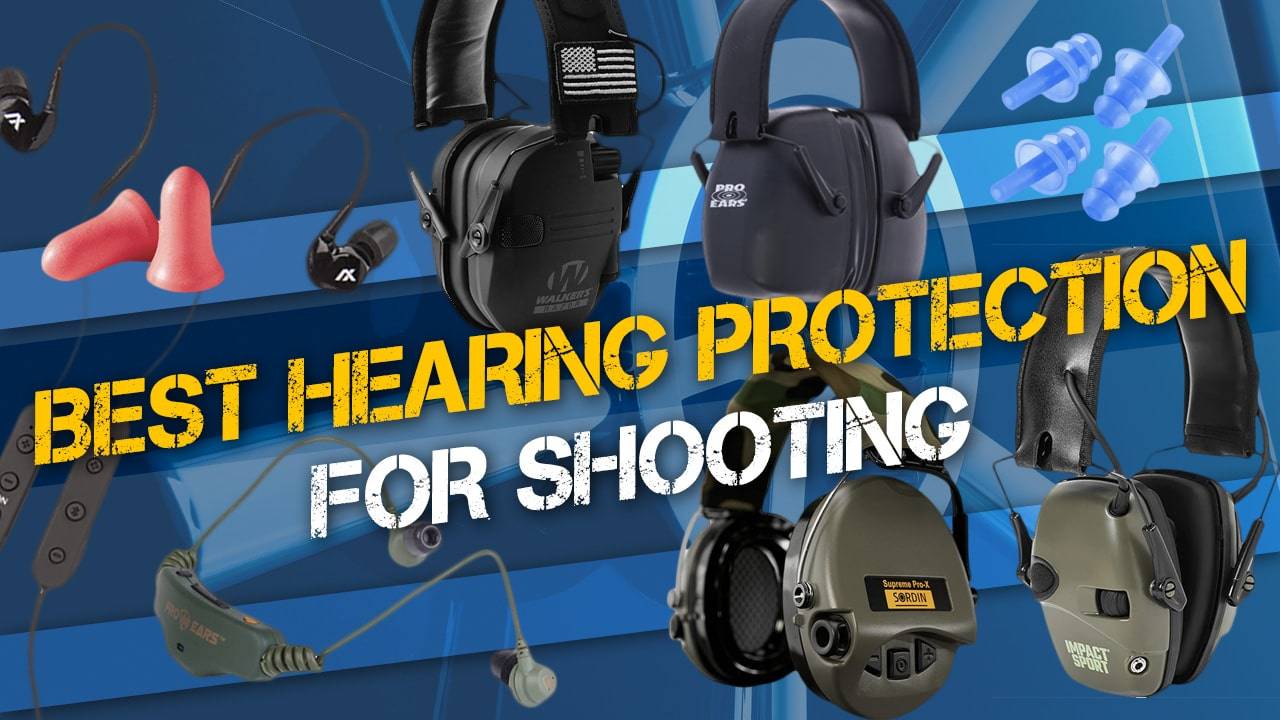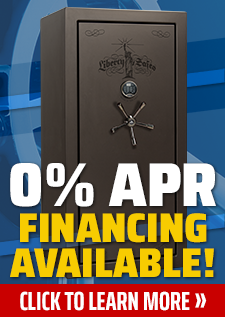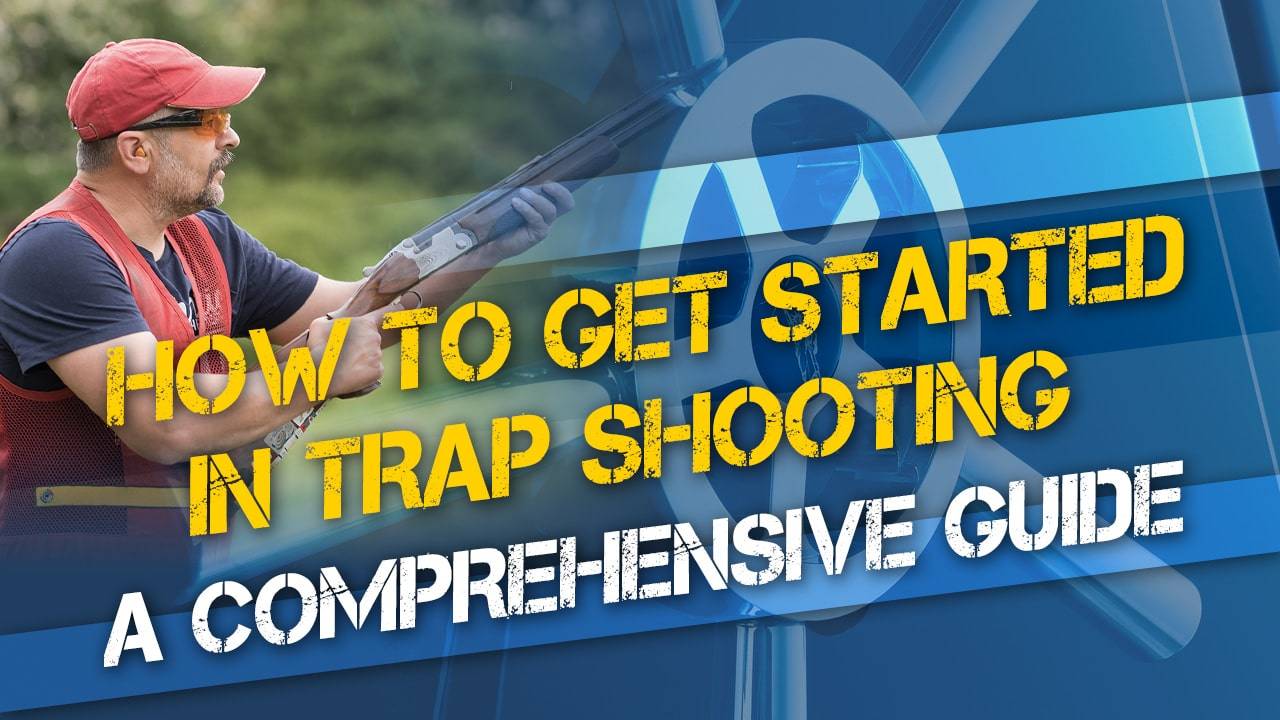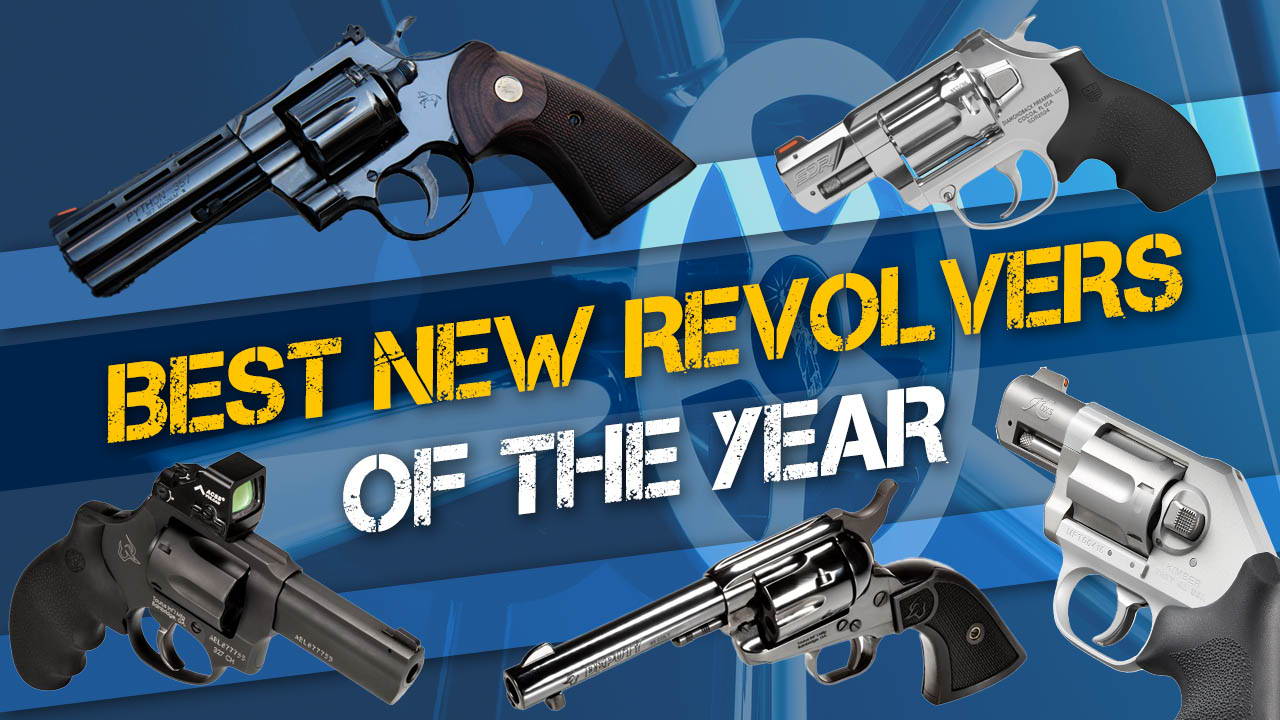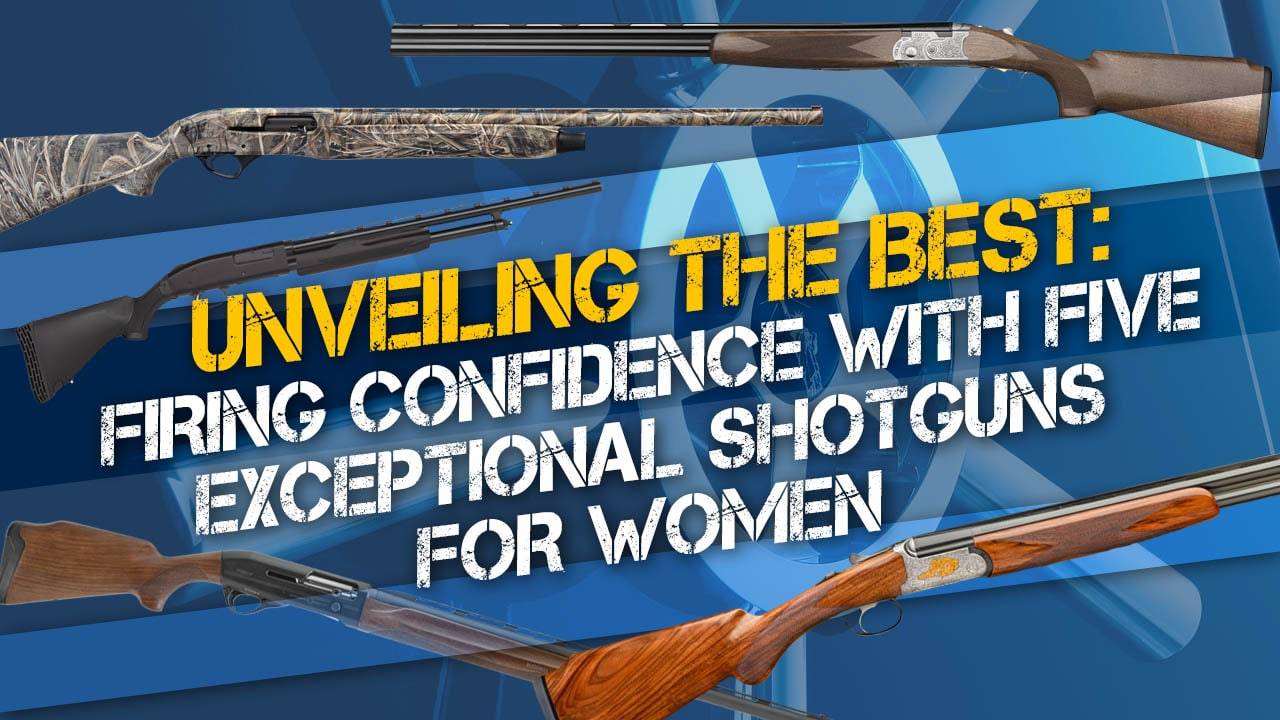Protecting your hearing when shooting is essential. Even one shot fired without proper hearing protection can permanently damage your hearing. Additionally, tinnitus, or persistent ringing/buzzing in the ears, is a growing problem for people who didn’t appreciate the need for hearing protection during concerts, loud factory environments, listening to loud stereos or earbuds, drumming, motorcycle riding, shooting, operating power equipment, or other loud activities.
Table of Contents
Hearing protection is also a fundamental safety issue for shooters and those around them. Gunshots can register up to 167 decibels (dB). Most experts say that exposure to sounds over 85 dB is potentially harmful over time, and 140 dB is the threshold of pain. (Remember, measuring sound by decibels uses a logarithmic scale, not a linear one. For every 6 dB increase, the actual noise doubles). Besides protecting your hearing, proper hearing protection also prevents new or inexperienced shooters from being startled as the gun fires, possibly jerking the trigger or dropping the gun. In this article, we’re going to go over some of our favorite forms of hearing protection. We’ll discuss the pros and cons of passive earmuffs, active or electronic earmuffs, foam/silicone earplugs, and tactical or electronic earplugs, including the best protection for the money. So listen up!
Please note: We are not physicians or audiologists. We just want you to protect yourself from hearing loss. This article is for informational purposes only. Neither Liberty Safe nor the author assumes any liability for the use or misuse of this information. Please consult a licensed physician or audiologist for recommendations and/or treatment for hearing problems.
Foam earplugs
Foam earplugs are the most common form of ear protection and are definitely the winner as far as protection versus cost. Even very inexpensive foam earplugs can provide near the maximum of around 33 decibels (dB) noise reduction rating (NRR) when properly used. Our favorites are the Howard Leight Max or Max Lite earplugs, which have an ergonomic shape and are comfortable to wear for most users. They have an NRR of 33 dB and cost between $0.15 a pair for uncorded when buying 200 pairs at a time or $0.26 a pair for the corded variety. The corded ones include a polymer cord connecting the earplugs so you can hang them around your neck when not in use. If you buy individual packages or 5 pairs at a time, they can cost over $0.50 a pair. However, if you buy in bulk from industrial safety equipment suppliers, you can get the price down to around ten cents a pair.
How to use foam earplugs properly
Proper use, however, is absolutely essential when using foam earplugs. In our estimation, around 95% of people don’t use foam earplugs correctly. If you just stuff them into your outer ear canal, they may only reduce noise by 10 dB or less. You need to roll the foam earplugs between your fingers and compress the foam into as small a cylinder as possible, then reach over the top of your head with one hand, lift up on the top of your ear to straighten out your ear canal, and then with the other hand, insert the earplug deep into your outer ear canal. Hold the earplug in place for about 8-10 seconds until you feel it expand against your ear canal. You’ll notice things getting a lot quieter as this happens.
If you don’t follow these instructions, you could suffer hearing loss even when using foam earplugs.
Among practical ear protection for shooting, foam earplugs have about the highest noise reduction rating of 32-33 when properly used (depending on the brand and style). For the price, there’s nothing more effective at protecting your hearing.
Pros and cons of foam earplugs
Some advantages of foam earplugs are very low cost, high effectiveness, portability, size, and weight. However, one of the most important benefits of using foam earplugs is they don’t interfere at all with your cheek weld when shooting rifles and shotguns.
The disadvantages of foam earplugs depend greatly on the user. However, some people really just don’t like the feeling of having things inserted into their ears. Using foam earplugs correctly requires that you roll them small and insert them well into the outer ear canal so they can seal against the noise. Some people find this uncomfortable or even painful, and some people just get weirded out by it and refuse to use them.
If you haven’t used earplugs or cleaned your ears in a while, you will likely get some ear wax sticking to the plugs when you remove them. This also grosses some people out (though it could be seen as an advantage; you’re cleaning your ears a little). If you have a lot of wax in your ear canal, inserting an earplug may push it into a solid mass and block your hearing, and require a doctor or audiologist to remove it, which can be painful.
Foam plugs also block all sounds, including normal conversation. This is a tradeoff many people accept in favor of superior hearing protection.
Additionally, foam earplugs should technically only be used once before disposing of them, which isn’t great for the environment nor your wallet (though the cost per pair is very low). Don’t be tempted to reuse foam plugs more than once or twice, as they can get nasty bacteria on them and can cause an ear infection.
Reusable silicone ear plugs for shooting
Many people prefer silicone earplugs over foam for various reasons. We like the cheap silicone plugs with three flanges, which you can get on Amazon for about $0.80 per pair normally, or about $0.42 on sale. This type of earplug also typically has an NRR of around 32-33 dB, but they are often easier to insert and use correctly compared to foam earplugs. It does help to use a similar technique as when using foam plugs, lifting up on the top of the ear to straighten the ear canal and inserting them firmly.
Some people find that silicone earplugs are more comfortable than foam earplugs (if you get the correct size for your ear). Additionally, silicone earplugs can be reused multiple times when washed off and sanitized between uses. You can also use them for swimming to prevent water from entering the ear. The silicone used in earplugs is food-safe and generally doesn’t react with most people’s skin, so it’s pretty hypoallergenic. And, like foam earplugs, silicone plugs don’t interfere with your cheek weld when shooting rifles or shotguns.
However, people who are very sensitive to having things inserted in their ears will likely not tolerate silicone earplugs either. Additionally, silicone is naturally pretty slippery, and oils from the skin, earwax, sweat, or vigorous activity can sometimes make them difficult to keep in place. If they slip out even partially, that means the sound is getting through, and you can suffer hearing damage while shooting.
Cleaning your outer ear canal and the silicone plugs with rubbing alcohol before inserting can help them stay in place longer if you’re insistent on using silicone earplugs during sweaty or vigorous activities.
Passive ear muffs
Passive earmuffs refer to their not including any electronics, microphones, Bluetooth connectivity, or sound-amplification technology, like the active earmuffs we’ll discuss later. Passive muffs are common in high-noise factory environments, as well as people operating dangerously loud equipment such as chainsaws or jackhammers.
Passive earmuffs are basically large, durable cups full of sound-deadening material that fit over the outer ear and are sealed against the head by foam or gel pads around the edges.
There are several internet sales sites claiming up to 41 NRR for their passive muffs, but we’ve been unable to find documentation of any testing methods to substantiate this claim. In general, most passive earmuffs have credible ratings of between 20 and 31 dB NRR using accepted ANSI or OSHA-approved testing methods (read more here). This rating greatly depends on getting a good seal around the ear as well as the method of testing. In general, quality foam or silicone earplugs, properly used, have a higher NRR than the majority of passive earmuffs.
Advantages of passive shooting earmuffs
So why would you choose passive earmuffs for shooting? There are several key advantages of using passive earmuffs compared to earplugs. First, you don’t have to insert anything into the ear canal. For people who are sensitive to this, passive or active earmuffs are a godsend. Second, they can be very comfortable when properly fitted. The most typical style includes a padded strap over the top of the head that connects the two muffs, and is spring loaded and adjustable so you can center the cups over the ears. People with different ear sizes can find larger or smaller cups to accommodate them. Passive earmuffs are also commonly fitted to hard hats or helmets in dangerous work environments.
Additionally, passive earmuffs can be very inexpensive, reusable ear protection. You can get 20 NRR earmuffs for less than $15. They last for years and are available in nearly any sporting or hardware store.
Disadvantages of passive hearing protection muffs
The primary disadvantage of passive earmuffs when shooting is they often interfere with your cheek weld when shooting rifles or shotguns. Having a bulky, hard cup over your ear prevents you from getting your eye aligned properly with the sights. Some types may be relieved to allow for the stock of a long gun, but it’s often not ideal. What’s more, the slimmer the muffs, the less effective they are generally.
Additionally, if you’re wearing eye protection (as you should when shooting), the temple/frames of the eye protection can prevent the sealing portion of the earmuffs from getting a complete seal around your ears. This can compromise noise reduction and cause hearing damage. Furthermore, it may be uncomfortable to have earmuffs pressing against your eye protection frames and into your head. There are dedicated shooting eye protection frames intended to be worn in conjunction with earmuffs with flexible/thin temples, but it can still be an issue. Spending a little more on gel cup pads can help with comfort and effective sealing around the earmuffs.
Typically, passive earmuffs aren’t as effective at blocking harmful levels of noise compared to properly used foam or silicone earplugs. If you spring for the highest-rated muffs, you can achieve around 31 NRR, but as noted above, the vast majority of commonly sold muffs have an NRR of 20-25. This may not be enough if you shoot a lot or indoors.
Finally, if you shoot on hot/sunny/humid days and wear passive muffs, you may find your ears and the area around them get very sweaty. This is one reason many shooters prefer to use in-ear protection, as you get airflow to your ears and head.
Best passive shooting ear muffs for the price
There are dozens, if not hundreds, of brands and models of passive earmuffs. As far as the best passive earmuffs for the cost, we like the Pro Ears Ultra Gel 29. These are comfortable, affordable (at around $30), and, above all, more effective than many cheaper passive earmuffs. With an NRR of 29 and comfortable gel pads to help seal around eye protection, the Pro Ears are definitely worth the money and would be our first choice for handgun shooters or spectators looking for effective ear muffs and who don’t need electronics.
Electronic ear muffs
Electronic earmuffs for shooting are overall our favorite choice for protecting our hearing. These have exploded in popularity over the past decade, and for good reason. Electronic muffs resemble standard passive ear muffs but include microphones, internal speakers, and electronics designed to amplify ambient sounds and conversation when needed while cutting out any sounds over about 82-85 dB. Many models now include Bluetooth connectivity for people who want to listen to music while doing yard work or shooting (though we certainly wouldn’t recommend this for people on a live range with range officers giving commands).
You can spend hundreds of dollars on tactical electronic shooting muffs. If you’re a buy-once-cry-once kind of person, have a look at the Sordin Supreme Pro-X, particularly the Slim variant. They’re made in Sweden and are approved according to ANSI S3.19-1974 as well as the European norms EN 352-1, EN 352-4, and EN 352-8 (standards for level-dependent attenuating earmuffs with audio entertainment input).
Video: MSA Sordin Supreme Pro X Electronic Hearing Protection Review
Sordin’s Supreme muffs are already excellent, but the Pro-X line gets upgraded waterproof microphones and sturdier electronics. There are both headband and neckband variants available, in several colors, and you can opt for a boom-microphone model for squad comms if desired. However, as with most premium electronic earmuffs, you also have to take the price into consideration. Sordin’s Supreme Pro-X generally hovers around the $300 mark, similar to the top-level electronic muffs from other reputable companies like Peltor (whose prices go up to $800 or more).
For those of us who don’t carry around a fat roll of Benjamins, there are some other choices that provide excellent value.
Video: Exclusive review: 3M ComTac VI
Best electronic shooting muffs for the money: Howard Leight Impact Sport
Our favorite electronic earmuffs for budget-conscious shooters are the Howard Leight Impact Sport muffs. The MSRP is currently $95, but these earmuffs are frequently on sale for around $45 on places like Amazon.
There’s a lot to like about these inexpensive electronic earmuffs. They are slim enough to be usable when shooting rifles and shotguns but have a respectable NRR of 22 decibels. They are extremely reliable (we have a pair that’s over 10 years old and still working fine). Batteries are easy-to-find AAA size, and they last for 350 hours of constant use. However, there’s a very handy automatic shut-off after 4 hours to prevent battery drain. If you’re wearing these for a long match and they shut off after 4 hours, you simply roll the volume control to click them off and back on again, and you’re good for another 4 hours.
The Impact Sport muffs actively listen and automatically cut off any loud impulse noises (like gunfire) above 82 dB. Plus, you can turn up the volume for sound amplification up to 4X. This means you can wear earplugs in combination with these earmuffs (more on this below) and still hear range commands and conversation while preserving your hearing. There are 2 high-gain, omnidirectional microphones that allow you to identify the source and direction of sounds, similar to how your ears naturally work.
Video: Howard Leight Impact Sport Electronic Hearing Protection Review
We also like how the Impact Sports’ microphones are recessed into the housing and protected by foam covers to reduce wind noise. The battery compartment cover acts as the external upper housing of one side and is easy to remove and replace. Some other designs require you to remove the inner cups to replace batteries, but not these.
They fold pretty flat so they don’t take up lots of room in your range bag, and they are pretty comfortable with the standard foam earpads. Our favorite upgrade is the optional gel-pad cups, which seal better around eye protection temples and don’t give you pressure points on your head after long days on the range.
Things we wish were better: The Impact Sport design was around before Bluetooth, so they aren’t designed for that capability. However, if you’re old-school and run a music player with a wired output jack (like the old Walkman-type headphone jack), you can input audio to the Impact Sports using its integral AUX-in port. The standard foam ear cups aren’t as comfortable as the upgraded gel ones and may not seal around some thicker eye protection. The padding on the headband could be improved as well.
Overall, though, as far as long time satisfaction with a product at a very reasonable price, we can’t recommend the Howard Leight Impact Sport electronic earmuffs highly enough.
Runner-up: Walker’s Razor Slim
At an MSRP of $79.99 but often for sale around $45, Walker’s Razor Slim is our second choice for a bang-for-the-buck electronic earmuff for shooting. Like the Howard Leight Impact Sport, the Razor Slim earmuffs are slender enough to allow comfortable shooting of rifles and shotguns. They also have an external battery compartment, use AAA batteries, and have an AUX input.
While Impact Sports has a single volume/on-off control wheel that governs both sides of the earmuffs, the Razor Slim uses independent volume controls for the left and right muffs. This can be useful if you have hearing damage in one ear and need to compensate. However, if you have normal hearing, it’s a little more of a hassle to have to turn on both sides of your earmuffs.
Another niggle is that, unlike the Razor Pro from Walker’s, the Razor Slim doesn’t have an auto-shutoff feature, so if you forget to turn them off, your batteries will be drained within a couple of days. We also wish the microphones were covered in a bit of foam to help dampen wind noise. Overall, though, a solid choice for an electronic muff at a good price.
Video: Walker's Razor Slim Electronic Hearing Protection Review
Tactical Earplugs
Tactical earplugs are the term for non-earmuff type hearing protection that goes into the ear canal. Similar to Bluetooth earbuds but with enhanced hearing protection, tactical earplugs or buds are becoming increasingly popular with shooters, hunters, and all types of people involved in an active outdoor lifestyle.
Tactical earplugs have the functionality of electronic earmuffs in that they block harmfully loud noises while amplifying ambient sounds so you can still hear range commands, conversation, and in many cases, music via Bluetooth connectivity. However, since this type of hearing protection uses in-ear plugs, you don’t have any interference with earmuffs contacting the buttstock of rifles or shotguns. You also get airflow to the outer ear so you don’t get sweaty ears on hot days.
Here’s one area where the technology hasn’t gotten to the point of being both effective and inexpensive. You can find cheap tactical plugs on Amazon, but we don’t recommend them at this point. In particular, tactical earplugs that have silicone buds are usually not rated for shooting if you read the information carefully. They may be comfortable for Bluetooth earbuds, but they don’t block enough noise to be safe when shooting. So, look for tactical earbuds or earplugs with high-quality foam earpieces.
Best tactical earplugs for the money: Pro Ears and AXIL
If you don’t care about Bluetooth capability and just want enhanced ambient hearing and effective noise suppression for shooting, have a look at the Pro Ears Stealth 28 HT. At an MSRP of $59-$79, they won’t break the bank and are comfortable and effective when shooting. These tactical earplugs have coiled cords connecting the battery pack at the rear with the earpieces, and the enclosed rechargeable battery uses a common USB-C port. The Stealth 28 HT gives about 25 hours of constant-on use, which is more than enough for a couple of long days at the range before charges. These earplugs have an NRR of 28, which is among the better ratings for this type of ear pro. Warranty is for 1 year.
If you can save your lunch money for a few weeks and step up to the AXIL GS Xtreme 2.0, you’ll be glad you did. They aren’t cheap at $199 MSRP but were developed by audiologists who also make hearing aids and other top-quality tech. The GS Xtremes have Bluetooth connectivity, and excellent audio quality, so you may not need your normal earbuds to listen to music. We’ve also found that the foam plugs included provide enough options to fit most people comfortably.
As with other tactical earplugs, you need to use the foam earpiece tips with the Xtreme 2.0s rather than the silicone options, which doesn’t effectively block the loudest noise. We also found we needed to press the earpieces into our ears pretty firmly to get them to stay in place while shooting. However, once pressed in place, they didn’t come out, even while we were running around the range during practical shooting matches.
These plugs are charged via a USB-C port and provide 8 hours of run time when using both the audio function and hearing enhancement features at the same time. If you run audio only, you get 9 hours; if you just use them for hearing enhancement, they’ll run for 25 hours between charges.
Once you try a really good set of tactical plugs, you may never go back to earmuffs or standard earplugs again.
Bonus tip: We don’t recommend the AXIL X-PRO Push Button Earplugs. These are a gimmicky type of passive earplug that’s supposed to allow you to hear normal sounds but close down when you push a button. It’s a mechanical rather than electronic system, and not only are these plugs uncomfortable, they don’t actually work as designed. The button mechanism on our example was broken when they arrived, and the other one worked for a few pushes and then failed. Definitely a waste of money. Some standard silicone earplugs would be preferable to these and are a lot more comfortable.
Hearing protection: Does shooting indoors vs. outdoors make a difference?
Absolutely. Shooting indoors, particularly in a shooting range divided by stalls, is MUCH louder than shooting outdoors. Sound waves bounce off of walls and other surfaces, and if you shoot indoors, you will want to take advantage of the maximum ear protection you can find… which brings us to our next point.
Combination of foam or silicone earplugs and ear muffs
For sustained high-noise environments, combining good-quality foam or silicone earplugs AND passive or active ear muffs over the ears might be what you need. This really shuts down the noise (when you insert the foam plugs properly, as noted above) and can not only protect your hearing but also reduce fatigue and mental fuzziness that can start to occur after hours on the job in a really noisy industrial floor.
It’s important to understand that the NRR of earplugs (around 33 decibels NRR for good ones) and ear muffs (up to around 31 NRR for the best ones) does NOT add up to a total of 64 dB NRR when using both plugs and muffs. Based on the ambient noise testing standard adopted by ANSI and OSHA, combining earplugs and earmuffs adds only around 5 extra dB of protection. Remember, as noted earlier, measuring noise by decibels uses a logarithmic scale, not a linear one. For every 6 dB reduction, the actual noise is cut in half. So adding muffs on top of properly used earplugs does add significant noise reduction and protection. But it’s not as simple as taking the NRR of the plugs plus the NRR of the muffs.
Why? Because a lot of the noise reaching your ears comes through your skull and tissue. In a loud-enough environment, it’s conceivable that you could be wearing proper earplugs and quality over-ear muffs and still suffer hearing damage if exposure was lengthy enough.
The best combination we’ve tried, particularly for indoor shooting, is using foam earplugs with electronic earmuffs over the top, turned up loud enough that you can still hear range commands and conversations. The foam plugs provide extra protection, and the earmuffs amplify spoken commands and conversations but automatically cut out anything over about 85 dB, like gunshots. Best of both worlds.
Store your shooting gear in a Liberty Safe
No matter what ear protection you choose to use when shooting, be sure to store your valuable gear and firearms in a US-made gun safe from Liberty. Not only does this help protect against theft, fire, and unauthorized access, but a properly dehumidified safe helps prevent mold and corrosion as well. Have a look at our interactive online catalog or find a dealer near you.
*Made in the U.S.A. from U.S. and Global Parts.


